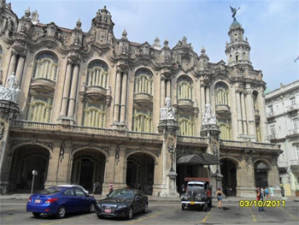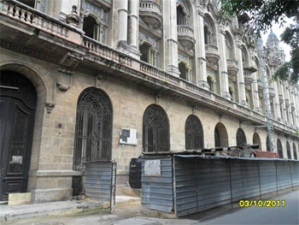The Havana Gran Teatro Needs Help

HAVANA TIMES, Oct. 13 — Some references that undoubtedly make clear clear the invaluable importance that the Havana Gran Teatro possesses deal with its very history. This coliseum has been the stage to some of the best performances in the Caribbean, yet the condition it’s in now doesn’t correspond to that value.
The Great Theatre of Havana is known as the oldest active theatrical institution in Latin America, for which Cuba is privileged to enjoy it. It opened on April 15, 1838, then under the name of “Gran Teatro Tacon.” Over its long history it has had other names, like “Gran Teatro Nacional,” “Teatro Estrada Palma” and “Teatro Garcia Lorca.”
Since its founding, the most prestigious artistic figures and world-renowned companies have climbed upon its stages. One needs only mention the ballet dancers Fanny Elssler, Anna Pavlova, Carla Fracci, Alexandra Ferri, Julio Bocca and Maximiliano Guerra.

Nor can we forget those stars from the island who embarked upon their careers there; artists such as Carlos Acosta, Jose Manuel Carreño, Lorna Feijoo, the Enrico Caruso Singers, and Teresa Venganza, and the actresses Sarah Bernhardt and Eleonora Dusse.
Then too, it has hosted the most internationally respected ballet companies, ones such as the Leningrad Kirov Ballet, Maurice Béjart’s Twentieth Century Ballet, the Royal Ballet of London, Moscow’s Bolshoi Ballet and the ABT of New York.

Adding to all of that have been important exponents of the piano, masters such as Sergei Rachmaninoff, Arthur Rubinstein and Daniel Barenboim, in addition to the guitarist Andres Segovia, the great French mime Marcel Marceau, and the most famous luminaries of art from the island, names like Ignacio Cervantes, Jose White, Ernesto Lecuona, Rita Montaner, Rosa Fornes and Alicia Alonso. In short, the list remains endless.
At the initiative of Alonso herself, it was in 1985 when the entire building was renamed the “Gran Teatro de La Habana,” reserving the name “Garcia Lorca” for its main hall (where since that date, some of the island’s most important cultural events have been held; among them the annual editions of the International Ballet Festival, which draws the most well-paid and highly acclaimed artists in the world of dance).
Today however, when we accessed the interiors of the fabled institution, we were astonished to find the condition of the most respected stage in Cuba. Though it has been undergoing restoration to its facade and its interior spaces for quite some time, this is proceeding with a notable sluggishness. Without analyzing the exact causes for the delays, the work remains incomplete although it is desperately needed to restore the dignity to this center of such tradition and that is deserving of such respect.

Viewers cannot only appreciate the theater’s excellent artistic performances, they are also witnesses to the neglect that reduces the seriousness of the institution, just as they can testify to the dawdling conservation work for which someone needs to answer.
We are aware of one example, out of many, on the top floor of one of the main areas providing access to the public access. Here, known as the “Paraiso” (Paradise), one finds their view blocked by tacky, ill-placed wood boards. In crowded theatrical functions — as usually occurs there — these contrast with the aesthetics and the supposed image that people expect from this iconic cultural site.
And what can one then say about the artists backstage, because the dust embedded in the stage’s main curtain urgently needs attention. This filth adds to the holes and tears that it also suffers, unfortunately generating negative comments like those in this article.
Of course everything related to this is minimal if we take a look at other areas. In fact there’s no need to even enter the building to get a sense of the disregard. Any passerby can confirm by only looking from the outside at the scaffolding that was erected several years ago but still remains on one side of the structure, now forming a part of the architecture.

This raises many questions. The main dance company in the country, the Ballet Nacional de Cuba (headquartered at the theater) — with so many tours to so many different geographic areas of the world every year — brings in a certain amount of income to the nation’s economy.
The company also requires dues from its membership, not counting the massive admissions proceeds generated by spectators who buy seats for each International Ballet Festival and other events that take place there. So why do we find the Great Theatre of Havana still in such a sorry state of neglect and decay?
Questions assail us when we see other construction and renovation projects progressing in such a short time across the country, including all those that fortunately the Office of the Historian of the City have taken charge of to give new life to the city. One needs only look at the new hotels and spaces designed in the historic center. These and many others undertakings compel us to make comparisons, though that is not the goal here.
“El Gran Teatro de La Habana,” in that it represents the island to the world, deserves to be a priority for its cultural importance. This institution is for Cubans what the Covent Garden is for Londoners, the Opera Theatre is for Parisians, and what the Teresa Carreño is for Venezuelans. In short, there exist places that signify an identity for their own histories, and the identity of our theater must be respected.





